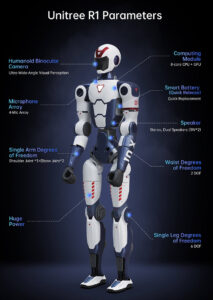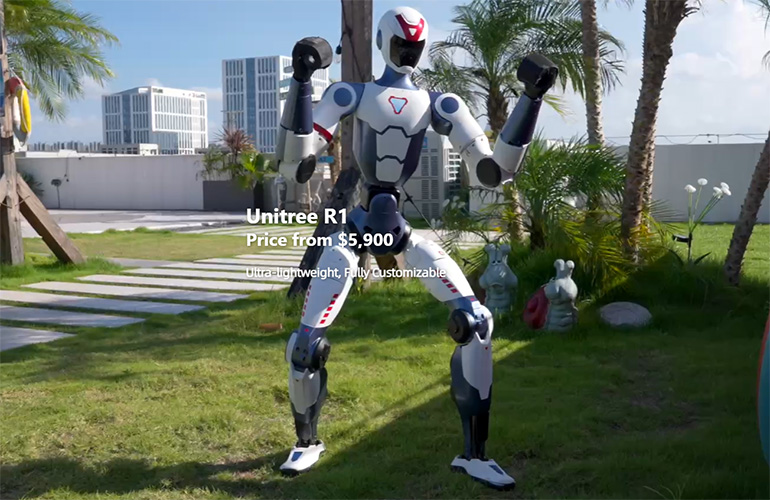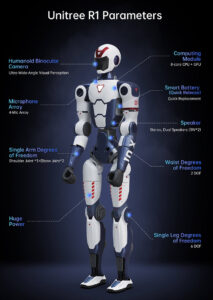For humanoid robots to find wide adoption, the developers and manufacturers will need to make them affordable and useful. Unitree last week unveiled its R1, with the standard model priced at $5,900 — a fraction of what most other humanoids currently cost.
The Hangzhou, China-based company kept the price down by keeping development and manufacturing in-house. In comparison, Unitree’s G1 robot cost more than $13,000.
“Our core components, including motors and reducers, are independently developed and produced in-house,” Unitree told The Robot Report. “Through years of robot development experience, we’ve further optimized the body structure. Additionally, as our commercialization matures and we achieve large-scale production and delivery, we’ve been able to achieve better cost control.”
Founded in 2016, Unitree has developed legged robots for consumer and industrial use. Last month, it obtained Series C funding that brought its its valuation to about 12 billion yuan ($1.7 billion U.S.).
The race to build commercially successful humanoids is still competitive, with new entrants weekly. Last week, EngineAI raised about $139 million as it moves toward mass production of its robots.

The R1 is lighter and more agile than the G1. (Click here to enlarge.) Source: Unitree
Unitree shares R1 specs
The R1 humanoid stands 1.2 m (3.9 ft.) tall and weighs about 25 kg (55.1 lb.), making it slightly smaller than the G1, which weighed 35 kg (77.1 lb.), and enabling it to move with “lifelike” agility.
Unitree posted a video (above) of the R1 performing actions such as side flips, handstands, and boxing moves. It showed off robot boxing in May.
“The new R1 boasts 26 joint modules (6 joints per leg x 2 + 2 waist joints + 5 joints per arm x 2 + 2 head joints),” said Unitree. “It integrates multimodal large models for voice and image, which greatly lowers the development threshold, allowing developers to build upon the R1 independently.”
A dexterous hand is optional for the educational variant of the R1. The new robot runs on a lithium battery and has an eight-core CPU.
The educational version also has the option of adding NVIDIA Jetson Orin for 40 to 100 TOPS (trillions of operations per second). Unitree said it will post more customization options to its website.
Autonomy still to come
Unlike the humanoids from, say, Boston Dynamics or Agility Robotics, Unitree’s R1 is remote-controlled.
“Autonomy is achievable but requires secondary development,” the company told The Robot Report. “We will have an EDU (educational) version that allows purchasers to perform secondary development, and it can use ROS 2.”
Unitree demonstrated voice control of its boxing robot in May.
The company’s initial video for the R1 ends with a warning that users should be aware of such robots’ current limitations. Given some of the hype around humanoids and safety standards still in development, it’s a reasonable warning.
“Currently, public perception of robots — e.g., believing robots can immediately perform household chores — has a gap with the actual state of robot development,” said Unitree. “The warning at the end of the video simply highlights that the robotics industry is still evolving, with many actions and scenarios still under development.”
“Global commercial adoption, such as entering factory settings, public service industries, and personal consumer sectors, will still take some time,” it added. “It’s not something that can be achieved immediately in the current stage.”
Unitree said it is actively exploring commercialization, but for now, it is focused on advancing the global humanoid robot industry. In the short term, the company said it hopes to use the R1 to promote the global robot development process.

The R1 humanoid is available in a consumer version and an educational version. Source: Unitree
Learn about humanoid development at RoboBusiness
The premiere event for technology and business development, RoboBusiness 2025 will be on Oct. 15 and 16 at the Santa Clara Convention Center. It will include a track on humanoid robotics.
Deepu Talla, vice president of robotics and edge AI at NVIDIA, will deliver the opening keynote on “Physical AI for the New Era of Robotics.” He will be followed by a panel on “Lessons Learned from the First Humanoid Deployments,” featuring:
- Jim Fan, director of AI and distinguished scientist at NVIDIA
- Katlyn Lewicke, head of global automation strategy and intel at GXO Logistics
- Melonee Wise, chief product officer at Agility Robotics
Other can’t-miss sessions on humanoids include:
- Humanoids for Real Applications: Mastering Safety and Performance, with Nikolai Ensslen, founder and CEO of Synapticon
- Advancements in Humanoid Actuation, with Jordan Schaeffer, strategic business development engineer at Novanta
- Integrating Behavioral Science into Humanoid Design, with Ram Devarajulu, vice president and head of robotics at Cambridge Consultants
In addition, RoboBusiness will feature informative sessions about robotics innovation, enabling technologies, and business development. Attendees can visit more than 60 exhibitors and experience numerous networking opportunities.
RoboBusiness will be co-located with DeviceTalks West, which focuses on surgical and medical devices. Registration is now open.
The post Unitree designs R1 humanoid robot to be agile and affordable appeared first on The Robot Report.

